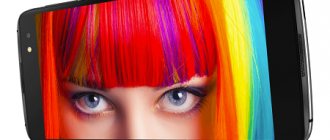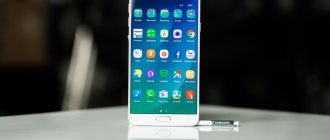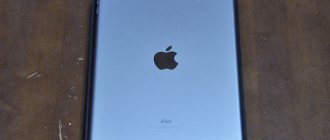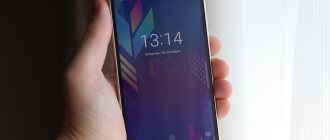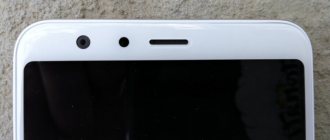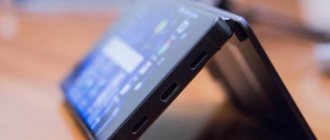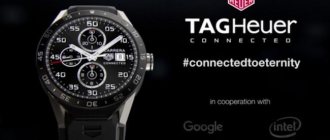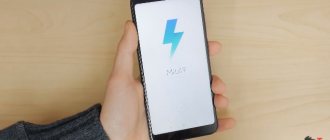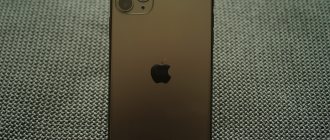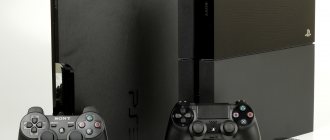Specifications
- Screen: 5.5″, IPS, 16 million colors, 1280×720 pixels, capacitive;
- Operating system: Android 6.0 Marshmallow;
- Processor: Qualcomm Snapdragon 210 MSM8909, Cortex-A7, 4 x 1.1 GHz;
- GPU: Qualcomm Adreno 304, 409 MHz;
- RAM: 1.5 GB;
- Built-in memory: 16 GB, support for microSD memory cards up to 32 GB;
- Cameras: Main 8 MP – LED flash, digital zoom, autofocus, f/2.0, HDR; front 5 MP – flash, digital. zoom;
- Video recording: 1280 x 720, 30 fps;
- Battery: Li-Ion 2500 mAh;
- Dimensions: 151.0 x 77 x 7.99 mm;
- Weight: 156 g;
- SIM slots: 2 microSIM/microSIM, Dual Standby;
- Communication: GSM: 850/900/1800/1900, UMTS: 1/2/5/8, FDD LTE B1/3/7/8/20/28A, EDGE HSPA+: Down - 42 Mbit/s, Up - 5.76 Mbit /s, 4G LTE Cat 4:Down - 150 Mbit/s, Up - 50 Mbit/s, WIFI: 802.11 a/b/g/n 2.4 GHz, Bluetooth 4.1, GPS (AGPS);
- Sensors: light, proximity, accelerometer, compass, Hall;
- Available colors: silver, black.
Advantages and disadvantages of the Pop 4+ phone
Alcatel Pop 4+ measures 77 mm wide, 151 mm long and 7.99 mm thick. With such dimensions it is convenient to operate the device with one hand. In addition, the weight of the device is about 156 grams. Even if you operate the device with one hand, its weight is almost not felt.
If we evaluate the overall ease of use of the phone taking into account the size and weight, then there will be no problems with everyday use.
The smartphone is equipped with a 4-core Qualcomm Snapdragon 210 MSM8909 processor, which is made at 28 nm. technical process.
The smartphone has 1.5 GB. RAM, which is quite enough. In very rare cases it will not be enough, but with this amount of RAM, you will rarely have problems.
The device's data storage capacity is 16 GB, and while this is enough for photos, it may not be enough for video shooting and a large number of games.
The phone is compatible with SD cards, so you can easily expand its memory. So you probably don't need to worry about storage capacity.
The Pop 4+ has a 5.5-inch display diagonal. It's quite big. Photos, videos and games will look great on this screen. It is also suitable for productive use, such as creating a business document.
The smartphone has a high-end display and any graphic content you display on it, including videos and games, will be displayed clearly.
The main camera of the phone has 7.99 megapixels, which should be enough in most cases. However, you may be slightly unsatisfied with the quality of the photos.
Also, the smartphone has a 4.92 megapixel front camera, which is average for smartphone cameras. This is good enough for taking selfies, but you may not be satisfied with group photos or their print quality.
The Alcatel Pop 4+ battery capacity is 2500 mAh, which is a typical capacity indicator. Compared to other smartphones, the Alcatel Pop 4+ battery life is average. You don't have to worry about anything during daily use. However, if you spend time surfing the internet or playing games, you might be a little underwhelmed by the battery life.
Equipment
The manufacturer provided the device for review in a white cardboard box with a sticker with the company name, device code name, barcodes, IMEI and the main supporting communication formats. A funny fact was that the sticker said that inside there was an Alcatel POP 4S 5095K in dark gray color, which caused me some confusion while getting to know the subject of the review.
Along with the box there was an A4 sheet with the (correct) name of the smartphone model and its technical characteristics.
Inside, in addition to the phone itself, there was a 5V 2A charger, a 1m long micro-USB cable for connecting to a PC, as well as in-ear headphones with two pairs of spare tips of different sizes.
POP 4S review, specifications
The POP 4S model, unlike the two younger versions, represents the mid-budget segment and has more interesting features. However, despite this, the body of the smartphone is still plastic. In addition to a more powerful processor, POP 4S is equipped with a fingerprint scanner. It is located on the front panel and is built right into the Home button, which is very convenient. However, the scanner is slow because it cannot recognize your fingerprint instantly: you need to press a button and hold your finger on it for a second. It would seem like just one second, but in the case of a fingerprint scanner it’s a lot.
Alcatel POP 4S filling:
- Housing: plastic and glass;
- Display parameters: IPS LCD, 16 million colors, resolution 1920 [1080 pixels, 5 inches, density 401 ppi;
- Processor: Mediatek Helio P10, eight-core ARM Cortex-A53 clocked at up to 1800 MHz, 64-bit, 28 nm;
- Graphics accelerator: Mali-T860, dual-core, 400 MHz;
- Amount of RAM: 2 GB, frequency 933 MHz;
- Storage capacity: 16 GB + memory card support;
- Main camera: 13 MP sensor, autofocus, flash, f/2.0 aperture, video 1080p at 30 fps;
- Front camera: 5 MP, viewing angle 84.4 degrees;
- Networks: 2G 850, 900, 1800, 1900 MHz, 3G HSDPA, 4G LTE Cat 6;
- Dual SIM cards;
- Connections: Wi-Fi 802.11 a/b/g/n/ac, Wi-Fi Direct, Bluetooth 4.2 LE, A2DP, Micro USB;
- Fingerprint scanner;
- Audio amplifier HD Voice Hi-Fi AKM4375;
- Battery: 2960 mAh;
- OS version: Android 6.0 (Marshmallow);
- Dimensions: 76.8x152x7.99 mm;
- Weight: 145 g;
- Antutu: 43,000 points;
- Cost: from 13,000 rubles.
As you can see, Alcatel POP 4S turned out to be twice as powerful as POP 4 and POP 4+, it received a fingerprint scanner and even a sound amplifier, which Alcatel’s flagships are famous for. All improvements to the smartphone have increased its cost by almost 2 times, but at the same time compared to competitors Xiaomi Redmi Note 3 (from 11,000 rubles), OUKITEL K6000 Pro (from 12,000 rubles), Meizu M3 Note 16Gb (from 17,000 rubles), Huawei Honor 5X (from 17,000 rubles), etc. Alcatel POP 4S looks very confident. In general, a standard set of characteristics and an acceptable price for the average.
Appearance
The body is made of plastic, but very high quality, as if it were metal. Without opening the back cover, which is also plastic, you won’t understand this.
The front panel is covered with glass. Above the display are, from left to right, an LED notification indicator, a front camera, light and proximity sensors, an earpiece and a flash.
Below the screen are the touch buttons “back”, “home” and “menu”. The home key is a design element of the smartphone and fits perfectly into it. The rest are “hidden” and are highlighted along with the central button when directly activated.
On the top edge of the POP 4 Plus there is a 3.5 mm jack and a microphone.
The manufacturer has placed physical power and volume keys on the right side of the smartphone, and they are located very high and close to each other, which is very inconvenient, especially considering the considerable size of the device.
Accordingly, there is nothing on the left side of the gadget.
At the bottom there is a microUSB connector and a second microphone.
The back panel, as mentioned earlier, is made of plastic. Painted on the outside. It's white inside. The cover has holes for the main camera, flash and speaker. The physical buttons are on the side of this panel.
The rear panel can be removed quite easily, as a result of which the user will be able to see not only the camera and flash, but also two slots for SIM cards in microSIM format, as well as a slot for a microSD card and a speaker. The battery is non-removable, hidden under an aluminum plate with a white sticker. You can insert and remove SIM cards and flash drives at any time; the connectors are independent and conveniently located on the edge.
The Alcatel POP 4 Plus is quite pleasant to hold in your hand. The device does not slip out. The only inconvenience during use is the buttons on the right side.
Alcatel POP 4, POP 4 Plus and POP 4S
At the February MWC 2020 exhibition, Alcatel, in addition to the flagship Idol line, also showed three mid-budget devices from the POP line. Alcatel presented an average (in terms of performance) POP 4S and two weak POP 4, and POP 4+. As a result, it turned out that POP 4S and POP 4+ acquired the currently standard screens with a diagonal of 5.5 inches, and the budget POP 4 got a smaller screen - only 5 inches. Externally, all three smartphones are very similar, especially the POP 4 and POP 4S+ models, since they differ from each other practically only in screen size. A special feature of the most advanced POP 4S model in the line is a mechanical Home button, which has a built-in fingerprint scanner. The public sector POP 4 and POP 4+ have only a round touch key in the same place, which is not as practical as the POP 4S. Alcatel decided not to make cases for its POP smartphones from metal, but instead made use of plastic. On the one hand, this is a minus, since metal cases look more premium, but on the other hand, the back cover is removable and you don’t have to bother with card trays, but simply install two SIM cards and a memory card into your smartphone at once. However, the removable cover does not involve disconnecting the smartphone by juggling the battery, since it is not removable.
Display
The presented gadget is equipped with a 5.5” screen with an IPS matrix that displays 16 million colors and has a resolution of 1280 x 720 - it may seem too small for such a large display. However, this is completely unnoticeable. The screen, like the entire front surface, is covered with glass with full lamination and an oleophobic coating, which, as usual, copes with its function to a certain degree of oiliness of the user’s fingers.
Color reproduction can be adjusted by hardware in the “Screen” section of the phone settings. You can change the color temperature and choose between Vivid and Natural saturation modes. Overall, color reproduction looks a bit dull, which may be due to the resolution and screen size used.
In the above situation, brightness does not come to the rescue. In conditions of excessive lighting, the phone perfectly replaces the mirror. The content displayed on the screen is barely visible not only due to insufficient brightness, but also due to glare. Taking photographs with this device in such conditions is extremely inconvenient, almost blindly.
Multitouch support – up to 5 points.
Iron
Alcatel POP 4 Plus runs on a Qualcomm Snapdragon 210 processor based on the MSM8909 chipset, with four ARM Cortex-A7 cores, 1.1 GHz each. This processor was developed for devices in the lower-average price category. Among its distinctive features are the 28 nm process technology and H.265 hardware decoding, but the main feature is the presence of a built-in LTE modem, which was previously only available for Snapdragon 400 and above.
The fact is that Alcatel POP 4 Plus differs from the usual “four” in the size of the screen at the same resolution and the increased amount of RAM – one and a half times, and internal memory – two times. In this situation, it looks strange that the phone runs on such a weak processor.
The graphics are handled by the integrated Qualcomm Adreno 304 graphics core with a maximum frequency of 409 MHz.
The test results are, to put it mildly, not very good. In 3DMark, the test recommended for this device for OpenGL ES 3.0 and 1080p unexpectedly showed a zero result. Things are better with OpenGL 2.0, but within the overall rating this device is very far from even the average result.
In practice everything is the same. There is no alternative between good quality textures and smooth frame transitions.
The actual amount of RAM, according to the phone's performance, is 1.4 GB. When the intensity of use is above average, the load is about 60%. The speed of operation is quite satisfactory, loading applications does not make you wait long.
Of the 16 GB of internal memory, 11.1 GB is available to the user. If desired, the memory can be expanded with a microSD card up to 32 GB.
Review of Alcatel Pop 4 (6) smartphone with 6-inch screen and metal body
Table of contents
- Specifications
- Appearance and ease of use
- Screen
- Camera
- Telephone and communications
- Software and multimedia
- Performance
- Thermal photographs
- Playing video
- Battery life
- Bottom line
The Alcatel Pop 4 line has been replenished with another smartphone. This series quite quickly grew into a whole family of mobile devices with a wide variety of sizes, and in order not to get confused, the developers began adding a number to the name of each new product corresponding to the screen diagonal size. Considering the obligatory “Pop 4” prefix, in general it does not look very elegant, but quite practical: the line now includes the Alcatel Pop 4 (10) tablet with a 10.1-inch screen and the 7-inch Alcatel Pop 4 (7) tablet phone. The hero of today's review belongs to the category of relatively inexpensive smartphones with a larger screen size (6 inches) and average specifications. According to the accepted rule, it was given the name Alcatel Pop 4 (6).
Alcatel Pop 4 (6) Key Features (Model 7070X)
- SoC MediaTek MT6755M (Helio P10), 8 cores ARM Cortex-A53 @1.8 GHz
- GPU Mali-T860 (MP2)
- Operating system Android 6.0
- Touch display IPS 6″, 1920×1080, 367 ppi
- Random access memory (RAM) 2 GB, internal memory 16 GB
- Nano-SIM support (1 pc.)
- MicroSD support up to 32 GB
- GSM/GPRS/EDGE networks (850/900/1800/1900 MHz)
- WCDMA/HSPA+ networks (900/1900/2100 MHz)
- LTE Cat.4 FDD networks (B3,7,8,20,28)
- Wi-Fi 802.11a/b/g/n (2.4 and 5 GHz)
- Bluetooth 4.1
- GPS, A-GPS, Glonass
- Micro-USB, USB OTG
- Main camera 13 MP, f/2.0, autofocus, 1080p video
- Front camera 5 MP, f/2.8, fixed. focus
- Proximity sensor, lighting sensor, accelerometer
- Battery 3500 mAh
- Dimensions 161×82×8 mm
- Weight 195 g
| Average price of Alcatel Pop 4 (6) |
| Yandex.Market widget |
| Alcatel Pop 4 Retail Offers (6) |
| Yandex.Market widget |
Appearance and ease of use
The design of the Alcatel Pop 4 (6) has something to praise for: the device looks neat and attractive, and even with a huge six-inch screen, it fits comfortably in the hand and fits well in your pockets thanks to its rather thin and elegant body with strongly rounded corners in plan.
The body elements fit well together, including plastic inserts on the top and bottom of the metal frame. All cutouts and interface connectors here are made of plastic.
The manufacturer decided not to disguise the plastic as metal and did not even make attempts to visually bring together different parts of the case: matte plastic is noticeably different in texture and color from the metal lid. All elements of the case are not easily soiled or slippery, the device does not collect fingerprints and does not slip in the hand.
The metal of the back wall is quite thin, and dents may appear on it - this is clearly visible in the photo of our test sample.
The back side of the case is usually given over to a camera with a flash and a fingerprint sensor pad. The camera with a chrome-plated shiny rim does not protrude beyond the surface. The device is stable when touching the screen, lies on a hard surface, practically without swaying.
There are no special complaints about the operation of the fingerprint scanner; the sensor responds quickly and accurately. The finger can be placed at any angle, any five fingers can be registered, and the same finger can be registered repeatedly. The flash has two multi-colored LEDs, but does not shine very brightly.
The entire front panel is covered with 2.5D glass with sloping edges. Above the screen are the usual sensors, a front camera peephole with its own flash, as well as an LED event indicator, which has detailed manual settings in the corresponding section.
There are no usual hardware buttons under the screen; the buttons are only on the screen. But at least the manufacturer took this fact into account and left a fairly thin strip of free space below the screen, which makes the front panel as a whole look modern and attractive. If the display is turned off, then it merges with the black fragments of the frame on the sides, which creates the effect of the notorious “frameless” body, but in reality there is nothing like it. There is a frame around the screen, and it is quite standard.
The main speaker here is located at the bottom end, it is hidden behind a series of holes made in the plastic, but there is nothing behind the symmetrically located holes on the other side of the central Micro-USB connector. The Micro-USB connector supports connecting external devices in USB OTG mode.
The top end is usually given over to a 3.5 mm headphone output, and the small hole for the auxiliary microphone is located on the back side of the case, closer to the fingerprint sensor area.
Cards in the Alcatel Pop 4 (6) are inserted into the side slot; you can install a Nano-SIM card and a microSD card on the slide. Our test sample only supported one SIM card.
There are no complaints about the buttons on the side: the keys are large, easy to feel blindly, quite pliable, but have a distinct springy action. The power key has distinct notches for easy identification. The buttons on this model are really quite pleasant to operate, this is one of the obvious advantages.
Alcatel Pop 4 (6) is available in only two colors: dark gray (graphite) and gold. The gray version has a black front panel under the glass, while the gold case has a white front panel; there are no other differences.
Screen
Alcatel Pop 4 (6) is equipped with an IPS display covered with 2.5D glass with sloping edges. The physical dimensions of the screen are 75x133 mm with a diagonal of 6 inches. Resolution is 1920x1080, pixel density is about 367 ppi. The frame around the screen, taking into account the large dimensions of the case itself, looks quite narrow: only 3 mm on the sides, 14 mm on the bottom, 13 mm on the top.
You can adjust the display brightness manually or use automatic adjustment based on the ambient light sensor. The AnTuTu test diagnoses support for 5 simultaneous multi-touch touches.
A detailed examination using measuring instruments was carried out by the editor of the “Monitors” and “Projectors and TV” sections Alexey Kudryavtsev
. Here is his expert opinion on the screen of the sample under study.
The front surface of the screen is made in the form of a glass plate with a mirror-smooth surface that is scratch-resistant. Judging by the reflection of objects, the anti-glare properties of the screen are no worse than those of the Google Nexus 7 (2013) screen (hereinafter simply Nexus 7). For clarity, here is a photograph in which a white surface is reflected in the switched off screens (on the left - Nexus 7, on the right - Alcatel Pop 4 (6), then they can be distinguished by size):
The screen of the Alcatel Pop 4 (6) is just as dark (brightness according to photographs is 112 for both). The ghosting of reflected objects in the Alcatel Pop 4 (6) screen is very weak, this indicates that there is no air gap between the layers of the screen (more specifically, between the outer glass and the surface of the LCD matrix) (OGS - One Glass Solution type screen). Due to the smaller number of boundaries (glass/air type) with very different refractive indices, such screens look better in conditions of intense external illumination, but their repair in the case of cracked external glass is much more expensive, since the entire screen has to be replaced. There appears to be a special oleophobic (grease-repellent) coating on the outer surface of the screen, but its effectiveness is low, and yet fingerprints are removed more easily and appear at a slower rate than with regular glass.
When manually controlling the brightness and displaying the white field in full screen, the maximum brightness value was about 400 cd/m², the minimum was 14 cd/m². The maximum brightness is high, which means, given the excellent anti-glare properties, readability even on a sunny day outdoors could be at a good level, but this is not the case, the actual brightness is usually much lower, explanations are given below. In complete darkness, the brightness can be reduced to a comfortable value. There is automatic brightness adjustment based on the light sensor (it is located to the left of the front camera eye). In automatic mode, as external lighting conditions change, the screen brightness both increases and decreases. The operation of this function depends on the position of the brightness adjustment slider. If it is 100%, then in complete darkness the auto-brightness function reduces the brightness to 50 cd/m² (a little high), at 50% - to 14 cd/m² (normal), and at 0% - to 2.6 cd/m² ( too dark). At the same time, regardless of the position of the brightness adjustment slider, in an artificially lit office (about 550 lux) and in a very bright environment (corresponding to outdoor lighting on a clear day, but without direct sunlight - 20,000 lux or a little more), the brightness increases to 400 cd/ m² (which is a bit high for an office). It turns out that the auto-brightness function does not work adequately. At any brightness level, there is no significant backlight modulation, so there is no screen flicker.
This smartphone uses an IPS matrix. In the micrograph you can see a typical IPS subpixel structure:
For comparison, you can see the gallery of microphotographs of screens used in mobile technology.
The screen has good viewing angles without significant color shift even with large viewing deviations from perpendicular to the screen and without inverting shades. For comparison, here are photographs in which identical images are displayed on the screens of Alcatel Pop 4 (6) and Nexus 7, while the screen brightness is initially set to approximately 200 cd/m², and the color balance on the camera is forcibly switched to 6500 K.
There is a white field perpendicular to the screens:
Note the good uniformity of brightness and color tone of the white field.
And a test picture:
The Alcatel Pop 4 (6) screen has natural color saturation, the image is slightly darkened, and the color balance is slightly different from the balance of the Nexus 7 screen.
Now at an angle of approximately 45 degrees to the plane and to the side of the screen:
It can be seen that the colors did not change much on both screens, but on the Alcatel Pop 4 (6) the contrast decreased to a much greater extent due to a very strong decrease in brightness.
And a white field:
The brightness at an angle of the screens decreased (at least 5 times, based on the difference in shutter speed), but with Alcatel Pop 4 (6) the drop in brightness is much greater. When deviated diagonally, the black field is slightly highlighted, but this is associated with a general decrease in brightness, and therefore is not an advantage. Black color at an angle has a slightly bluish tint. The photographs below demonstrate this (the brightness of the white areas in the direction perpendicular to the plane of the screens is the same!):
And from another angle:
When viewed perpendicularly, the uniformity of the black field is poor:
The contrast (approximately in the center of the screen) is high - about 1000:1. The response time for the black-white-black transition is 24 ms (12 ms on + 12 ms off). The transition between halftones of gray 25% and 75% (based on the numerical value of the color) and back takes a total of 34 ms. The gamma curve, constructed using 32 points with equal intervals based on the numerical value of the shade of gray, did not reveal any blockage in either the highlights or the shadows. The exponent of the approximating power function is 3.33, which is significantly higher than the standard value of 2.2, but this does not make any difference (see below).
This device has a very aggressive dynamic adjustment of the backlight brightness in accordance with the nature of the output image - on average dark images, the backlight brightness is greatly reduced. As a result, the resulting dependence of brightness on hue (gamma curve) does not correspond to the gamma curve of a static image, since the measurements were carried out with sequential display of shades of gray on almost the entire screen. For this reason, we carried out a number of tests - determining contrast and response time, comparing black illumination at angles - (however, as always) when displaying special templates with a constant average brightness, and not monochromatic fields in the entire screen. In general, such a non-switchable brightness correction does nothing but harm, since constantly changing the screen brightness can at least cause some discomfort, reduce the visibility of gradations in shadows in the case of dark images and the readability of the screen in bright light, since in average images the backlight brightness is not the lightest is underestimated, but there is not an excess of it anyway. For example, when displaying a black field on one half of the screen and a white field on the other, the maximum brightness is only 186 cd/m².
Color gamut is close to sRGB:
The spectra show that the matrix filters moderately mix the components with each other:
As a result, the colors have a natural saturation. The balance of shades on the gray scale is more or less normal, since the color temperature is not much higher than the standard 6500 K, and the deviation from the blackbody spectrum (ΔE) is approximately 10, which is considered an acceptable indicator for a consumer device. At the same time, color temperature and ΔE change little from hue to hue - this has a positive effect on the visual assessment of color balance. (The darkest areas of the gray scale can be ignored, since color balance there is not very important, and the error in measuring color characteristics at low brightness is large.)
This device allows you to select one of three profiles and try to adjust the color temperature.
There is zero meaning in this, since in the profile Bright
The color contrast is greatly lifted, which looks terrible, and in the
Natural
the only visible change is a decrease in brightness. The color temperature slider is also useless, since moving it does little to change the actual color temperature, basically it just increases ΔE. Note that in the description of the settings of this device there is a delusional argument for reducing the intensity of the blue component: supposedly blue light causes eye damage. Let us remember that the only harm that too bright light from a screen can cause is disruption of the circadian rhythm, and even then the screen must be very bright for this to happen.
Let's summarize: formally the screen has a high maximum brightness, but in reality it is lower due to aggressive dynamic adjustment of the backlight brightness, therefore, even despite its excellent anti-glare properties, the device can be used with great difficulty in real life outdoors on a sunny summer day. For conditions of complete darkness, you can set a comfortable brightness level. There is also a mode with automatic brightness adjustment, but it does not work adequately. The advantages of the screen include the absence of flicker, as well as a color gamut close to sRGB and an acceptable color balance. Significant disadvantages include a weak oleophobic coating, a very strong decrease in brightness at an angle, poor uniformity of the black field, as well as non-disabled dynamic adjustment of the backlight brightness. The screen quality is not high.
Camera
The front camera takes pictures with a maximum resolution of 5 megapixels and has a lens (f/2.8) with a fixed focus. The front camera in this smartphone is equipped with its own flash, which is rare. However, you won’t be able to rejoice at this fact, because the quality of the images is very modest and the detail is low.
The main camera uses a module with a 13-megapixel sensor and a lens with a maximum aperture of f/2.0; it is equipped with slow autofocus. The controls are simple and convenient, there is a dedicated HDR mode, as well as a simple manual mode with variable values of light sensitivity (up to ISO 1600), white balance, and exposure compensation. Additional features of the camera include the ability to scan QR codes and a retouching mode for captured images.
The camera can shoot video in maximum resolution up to Full HD @30 fps, there is no stabilization function. Apart from the fact that handheld shooting on the go is jerky, the camera copes well with video shooting: sharpness, color rendition and detail are normal, there are no artifacts in the image, the video is smooth, without jerks. The sound is recorded cleanly and clearly audible, and the noise reduction system copes well with its tasks.
- Video No. 1 (38 MB, 1920× [email protected] fps, H.264, AAC)
- Video No. 2 (24 MB, 1920× [email protected] fps, H.264, AAC)
- Video No. 3 (27 MB, 1920× [email protected] fps, H.264, AAC)
Below are examples of photographs with our comments on quality. Our specialist Anton Soloviev
.
| The sharpness across the field of the frame and in the plans is not bad, although in medium plans the program already noticeably interferes. | |
| Good sharpness in distant shots. | |
| The camera copes with macro photography. | |
| The text is well done. | |
| Large areas of blur in the corners of the frame. | |
| Details merge already in the middle plans. |
The camera has many shortcomings. Large areas of blur are noticeable in almost all frames. The program often behaves too aggressively and spoils details on all plans. And color rendition and dynamic range leave much to be desired. As a result, the camera can only be recommended for undemanding documentary shooting.
Telephone and communications
Alcatel Pop 4 (6) supports all 3 bands used in Russia (Band 3, 7, 20) of LTE FDD Cat.4 frequencies (download speed up to 150 Mbit/s). Within the city limits of the Moscow region, the device behaves confidently, and the quality of signal reception is not satisfactory.
The smartphone supports both Wi-Fi bands (2.4 and 5 GHz), and has Bluetooth 4.1. You can organize a wireless access point via Wi-Fi or Bluetooth channels. But the device does not have NFC support. The navigation module works with both GPS (with A-GPS) and the domestic Glonass, but without the support of the Chinese Beidou. During a cold start, the first satellites are detected within the first tens of seconds. The positioning accuracy is not satisfactory. Unfortunately, the magnetic compass required for navigation programs was not found in the device, although the official specifications on the company website promise its presence.
The phone application supports Smart Dial. The settings for sorting and displaying contacts from the phone book are standard for Android. In conversational dynamics, the voice of a familiar interlocutor is generally recognizable, and the sound is satisfactory. The vibration alert is not very powerful.
Software and multimedia
The software platform used is Google Android, not the latest version 6.0, without any of its own shell. It is possible to update over the air (OTA). There is no alternative interface as such. However, the work with gestures has been significantly expanded, the ability to wake up the screen by tapping has been added, taking a screenshot with a three-finger gesture has been implemented, and turning the case over to mute the call signal has been implemented. Naturally, there is a choice of various alternative design themes; you can also reassign the buttons in the panel and reduce the working area of the screen for ease of operation with the fingers of one hand.
There are quite a few third-party applications pre-installed: a comprehensive Boost utility, the Opera Mini browser, a package for working with office programs WPS Office, Yandex applications, a full set of social network clients. In addition, traditionally Alcatel also has its own Application Center, where you can download many interesting programs for free, including some paid games. SwiftKey is pre-installed as a keyboard with continuous typing.
To listen to music, you use your own player with a wide range of settings and audio effects, Waves MaxxAudio. However, both in headphones and through the speaker, the device sounds rather banal, the sound is of average volume, it does not impress with its purity, density and richness, everything is at an average level. The recorder demonstrates average sensitivity. There is an FM radio that works with headphones connected as an antenna.
Performance
The Alcatel Pop 4 (6) hardware platform is based on a single-chip 64-bit MediaTek MT6755M system, made using 28-nanometer technology. This is a stripped-down version of the MT6755 (Helio P10), here the older ARM Cortex-A53 cores have a frequency of 1.8 GHz, not 1.95 GHz (there are eight CPU cores in total, [email protected] .8 GHz + [email protected] .0 GHz). The dual-core Mali-T860 GPU is responsible for graphics processing. The amount of RAM is only 2 GB, and the built-in flash memory is 16 GB. Of these, 10 GB of storage is free and on average about 600 MB of RAM. According to these characteristics, the smartphone does not even qualify for the middle class.
It is possible to expand the memory by installing a microSD card; you can install applications on the memory card. It is possible to connect external flash drives in USB OTG mode.
Helio P10 is a currently popular platform designed for mid-range smartphones. This is not exactly a budget solution; even in this stripped-down form, the platform scores more than 45K points in the AnTuTu test. It is slightly inferior to the same mid-level SoC Qualcomm Snapdragon 625, it is in the middle between it and the lower level and performance Snapdragon 430. There are no special complaints about the platform; the smartphone so far confidently copes with basic tasks, including spectacular games. Mortal Kombat X, for example, runs on a smartphone without noticeable slowdowns, and you can play comfortably.
Testing in comprehensive tests AnTuTu and GeekBench:
For convenience, we have compiled all the results we obtained when testing the smartphone in the latest versions of popular benchmarks into tables. The table usually adds several other devices from different segments, also tested on similar latest versions of benchmarks (this is done only for a visual assessment of the obtained dry figures). Unfortunately, within the framework of one comparison it is impossible to present the results from different versions of benchmarks, so many worthy and relevant models remain “behind the scenes” - due to the fact that they once passed the “obstacle course” on previous versions of test programs.
| Alcatel Pop 4 (6) (MediaTek Helio P10 (MT6755M)) | Honor 6X (HiSilicon Kirin 655) | Lenovo K6 Note (Qualcomm Snapdragon 430) | Asus Zenfone 3 (Qualcomm Snapdragon 625) | Xiaomi Redmi 4X (Qualcomm Snapdragon 435) | |
| AnTuTu (v6.x) (bigger is better) | 46483 | 56991 | 44418 | 63146 | 43239 |
| GeekBench (v4.x) (bigger is better) | 708/2762 | 787/3300 | 635/2071 | 831/4092 | 683/2063 |
Testing the graphics subsystem in gaming tests 3DMark, GFXBenchmark and Bonsai Benchmark:
When testing in 3DMark, the most powerful smartphones now have the ability to run the application in Unlimited mode, where the rendering resolution is fixed at 720p and VSync is disabled (which can cause the speed to rise above 60 fps).
| Alcatel Pop 4 (6) (MediaTek Helio P10 (MT6755M)) | Honor 6X (HiSilicon Kirin 655) | Lenovo K6 Note (Qualcomm Snapdragon 430) | Asus Zenfone 3 (Qualcomm Snapdragon 625) | Xiaomi Redmi 4X (Qualcomm Snapdragon 435) | |
| 3DMark Ice Storm Sling Shot ES 3.1 (bigger is better) | 318 | 378 | 288 | 466 | 292 |
| GFXBenchmark Manhattan ES 3.1 (Onscreen, fps) | 4 | 5 | 4 | 6 | 10 |
| GFXBenchmark Manhattan ES 3.1 (1080p Offscreen, fps) | 4 | 5 | 4 | 6 | 4,5 |
| GFXBenchmark T-Rex ES 2.0 (Onscreen, fps) | 14 | 19 | 15 | 22 | 26 |
| GFXBenchmark T-Rex ES 2.0 (1080p Offscreen, fps) | 14 | 19 | 16 | 23 | 16 |
Browser cross-platform tests:
As for benchmarks for assessing the speed of the javascript engine, you should always make allowance for the fact that their results significantly depend on the browser in which they are launched, so the comparison can only be truly correct on the same OS and browsers, and this is possible during testing not always. For Android OS, we always try to use Google Chrome.
| Alcatel Pop 4 (6) (MediaTek Helio P10 (MT6755M)) | Honor 6X (HiSilicon Kirin 655) | Lenovo K6 Note (Qualcomm Snapdragon 430) | Asus Zenfone 3 (Qualcomm Snapdragon 625) | Xiaomi Redmi 4X (Qualcomm Snapdragon 435) | |
| Mozilla Kraken (ms, less is better) | 11255 | 9587 | 11298 | 8179 | 10848 |
| Google Octane 2 (bigger is better) | 3497 | 4428 | 3191 | 5036 | 3375 |
| SunSpider (ms, less is better) | 1709 | 1084 | 1365 | 877 | 1297 |
AndroBench memory speed test results:
Thermal photographs
Below is a thermal image of the rear
surface obtained after 10 minutes of battery testing in the GFXBenchmark program:
Heating is more localized in the upper part of the device, which apparently corresponds to the location of the SoC chip. According to the heat chamber, the maximum heating was 36 degrees (at an ambient temperature of 24 degrees), which is not very much.
Playing video
To test the omnivorous nature of video playback (including support for various codecs, containers and special features, such as subtitles), we used the most common formats, which make up the bulk of the content available on the Internet. Note that for mobile devices it is important to have support for hardware video decoding at the chip level, since it is most often impossible to process modern options using processor cores alone. Also, you shouldn’t expect a mobile device to decode everything, since the leadership in flexibility belongs to the PC, and no one is going to challenge it. All results are summarized in a table.
| Format | Container, video, sound | MX Video Player | Standard player |
| 1080p H.264 | MKV, H.264, 1920×1080, 24 fps, AAC | plays normally | plays normally |
| 1080p H.264 | MKV, H.264, 1920×1080, 24 fps, AC3 | plays normally | plays normally, no sound |
| 1080p H.265 | MKV, H.265, 1920×1080, 24 fps, AAC | plays normally | plays normally |
| 1080p H.265 | MKV, H.265, 1920×1080, 24 fps, AC3 | plays normally | plays normally, no sound |
Further testing of video playback was performed by Alexey Kudryavtsev
.
We did not find the MHL interface, like Mobility DisplayPort, in this smartphone, so we had to limit ourselves to testing the output of video files on the screen of the device itself. To do this, we used a set of test files with an arrow and a rectangle moving one division per frame (see “Method for testing video playback and display devices. Version 1 (for mobile devices)”). Screenshots with a shutter speed of 1 s helped determine the nature of the output of frames of video files with various parameters: the resolution varied (1280 by 720 (720p), 1920 by 1080 (1080p) and 3840 by 2160 (4K) pixels) and frame rate (24, 25, 30, 50 and 60 fps). In the tests we used the MX Player video player in the “Hardware” mode. The test results are summarized in the table:
| File | Uniformity | Passes |
| 4K/60p (H.265) | cannot be played | |
| 4K/50p (H.265) | cannot be played | |
| 4K/30p (H.265) | cannot be played | |
| 4K/25p (H.265) | cannot be played | |
| 4K/24p (H.265) | cannot be played | |
| 4K/30p | cannot be played | |
| 4K/25p | cannot be played | |
| 4K/24p | cannot be played | |
| 1080/60p | Fine | No |
| 1080/50p | Fine | No |
| 1080/30p | Fine | No |
| 1080/25p | Fine | No |
| 1080/24p | Fine | No |
| 720/60p | Fine | No |
| 720/50p | Fine | No |
| 720/30p | Fine | No |
| 720/25p | Fine | No |
| 720/24p | Fine | No |
Note: If both columns have Uniformity
and
Skips
are given green ratings, this means that, most likely, when watching films, artifacts caused by uneven alternation and skipping of frames will either not be visible at all, or their number and visibility will not affect the viewing comfort. Red marks indicate possible problems with playback of the corresponding files.
According to the criterion of frame output, the quality of playback of video files on the screen of the smartphone itself is good, since frames (or groups of frames) can (but are not required) be output with more or less uniform alternation of intervals and without skipping frames. Note that in the case of 60 fps files, usually one frame per second is displayed longer than the rest. The reason is a slightly increased screen refresh rate of 61 Hz. When playing video files with a resolution of 1920 by 1080 pixels (1080p) on a smartphone screen, the image of the video file itself is displayed exactly along the border of the screen, one to one in pixels, that is, in the original resolution. The brightness range displayed on the screen corresponds to the standard range of 16-235: in the shadows, only a couple of shades merge with black, and in the highlights all gradations are displayed.
Battery life
The non-removable lithium-polymer battery installed in the Alcatel Pop 4 (6) has an average capacity of 3500 mAh by modern standards, but even from such a battery we expected more impressive battery life results. In reality, in all usage scenarios, the device demonstrates a barely satisfactory result. In normal, average operating mode, the hero of the review will last no longer than a day without recharging - obviously, this is due to the larger than usual screen with a fairly high resolution and not the most economical SoC.
Testing has traditionally been carried out at the usual level of energy consumption without using energy-saving functions, although the device naturally has them.
| Battery capacity | Reading mode | Video mode | 3D Game Mode | |
| Alcatel Pop 4 (6) | 3500 mAh | 11:00 am | 7 hours 50 minutes | 4 hours 40 minutes |
| Honor 6X | 3340 mAh | 15:00 | 10:20 am | 4 hours 40 minutes |
| Lenovo K6 Note | 4000 mAh | 20:30 | 14:00 | 6:30 a.m. |
| Asus Zenfone 3 | 3000 mAh | 12:00 pm | 9:40 a.m. | 6:30 a.m. |
| Xiaomi Redmi 4X | 4100 mAh | 19:50 | 15:30 | 9:00 a.m. |
Continuous reading in the FBReader program (with a standard, light theme) at a minimum comfortable brightness level (brightness was set to 100 cd/m²) lasted until the battery was completely discharged for about 11 hours, and when continuously watching videos in high quality (720p) with the same brightness level via a home Wi-Fi network, the device operates for less than 8 hours. In 3D gaming mode, the smartphone was unable to pass the 5 hour mark, but a lot here, of course, depends on the specific game.
From a standard AC adapter with a maximum output current of 2 A, the smartphone is charged within 2 hours 15 minutes with a current of 1.85 A at a voltage of 5 V. Wireless charging is not supported.
Bottom line
The not very powerful SoC MediaTek Helio P10, and even in a stripped-down version, the low quality of the 6-inch screen, modest capabilities of the camera and sound system, barely satisfactory battery life - all these are quite significant shortcomings that are worth paying attention to when buying an Alcatel Pop 4 smartphone (6) priced at 14 thousand rubles. The situation with support for SIM cards is not entirely clear: so far there is only a model on sale that supports one single SIM card, which is almost nonsense for an Android smartphone. You can also find fault with the lack of an NFC module and a magnetic compass. The body is nice, but it is not all metal. In general, the Alcatel tablet phone turned out to be far from ideal, even with a low price discount.
Software
Alcatel POP 4 Plus runs on the Android 6.0 Marshmallow operating system with an interface modified by the manufacturer. The changes affected the main menu, which automatically categorizes applications in alphabetical order. I was unable to return the menu to its “normal” appearance. In the settings, you can select the effect of turning off the screen: smooth fading or “old TV”. The second one looks pretty funny.
Along with the Play Music application, the OneTouch Music Lite player is installed with the ability to listen to music both from the phone’s memory and the Deezer online service.
User Interface and Operating System
Alcatel POP 4 Plus runs Android 6.0.1 Marshmallow operating system. Some nice additions from the manufacturer include a quick access panel on the lock screen and the ability to zoom in on images in the gallery and the camera frame with one finger. The main menu sorts apps alphabetically and there doesn't seem to be any way to change this.
In the settings, you can select the effect of turning off the screen: smooth fading or “old TV”. The second one looks pretty funny.
Among the preinstalled applications there are standard applications for the manufacturer: free messengers WhatsApp, Facebook, Evernote, Chrome, AVG antivirus, Shazam, Instagram, Skype, Twitter, WPS Office. There are a couple of games.
It is suggested to use “Mix” as a music application. Through it you can not only listen to music, but also mix it, apply different effects, just turn the device to horizontal orientation.
Sound
The smartphone is equipped with a speaker, which is located on the reverse side, at the bottom. The sound quality is mediocre, low frequencies are not audible at all, mids are a bit, and most of all highs. The sound is "dry". However, the speaker volume is good. Maximum level – 82.4 dB.
In-ear headphones are a nice addition to your smartphone. Listening to music is a pleasure. The depth of the “bass” and the clear surround sound of each instrument are pleasing. However, the disadvantage of the headphones is the telephone control unit (remote). It is very small in size and has only one button, no volume controls.
The headset serves as an antenna for listening to FM radio both in headphones and through the gadget’s speaker.
Connection
The speaker is loud enough. Noise cancellation works well. When talking in a car while driving with the windows open on a busy street, the interlocutor hears only the voice of the speaker, there is silence all around.
The advantage is that the smartphone supports the LTE communication standard. Interestingly, where other phones do not receive 3G, the gadget receives a 4G signal. But, of course, everything depends on the telecom operator.
The Wi-Fi module does its job perfectly. The connection is clear even at a great distance from the router. There are no breaks.
The GPS module almost instantly “saw” 24 satellites, of which 15 “saw” it in response.
Camera
The main camera takes photos with a resolution of up to 8 megapixels. There is a single-color LED flash, autofocus, and digital zoom. Available modes: auto, HDR, panorama, QR scanner, auto retouch. Product photography is better than landscape photography.
The front camera takes pictures up to 5 megapixels. There is a flash, digital zoom, fixed focus. Of all the modes, only automatic and auto retouch are available.
Both cameras shoot 1280 x 720 HD video.
